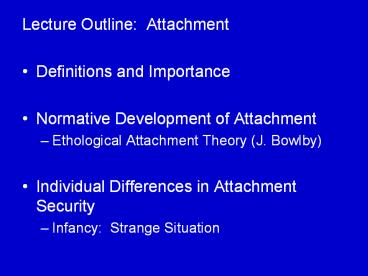Lecture Outline: Attachment - PowerPoint PPT Presentation
Title:
Lecture Outline: Attachment
Description:
Avoid the parent during reunion (to different degrees) Insecure-Resistant or Ambivalent (C) ... of the social environment (e.g., the family environment) ... – PowerPoint PPT presentation
Number of Views:49
Avg rating:3.0/5.0
Title: Lecture Outline: Attachment
1
- Lecture Outline Attachment
- Definitions and Importance
- Normative Development of Attachment
- Ethological Attachment Theory (J. Bowlby)
- Individual Differences in Attachment Security
- Infancy Strange Situation
2
- Attachment An enduring emotional tie that
unites one person to another, over time and
across space
3
- Attachment Behaviors
- Behaviors that function to bring the infant/child
physically closer to the caregiver - Exs crying, following, clinging
4
- Why is parent-child attachment important?
- First relationship that infants experience
- May serve as a model for other relationships
- May affect the development of self-concept
5
- Normative Development of Attachment
- Ethological Attachment Theory (J. Bowlby)
- Attachment behavior evolved because it is
adaptive for survival - Keeps infants physically close to caregivers and
away from danger - Increases the chances of infant survival and
reproductive success
6
- Evidence (Ethological Attachment Theory)
- Animals that stray from a group are much more
vulnerable to attack - Attachment behavior in animals (including
humans) - Occurs more frequently in those most vulnerable
to predators (e.g., the young) - Increases in frightening situations
7
- Individual Differences in Attachment Security
- Infancy Strange Situation
- Mother and infant in laboratory playroom
- Stranger enters, talks to mothers, engages infant
- Mother leaves (stranger stays)
- Mother returns (stranger leaves)
- Mother leaves (baby alone)
- Stranger returns
- Mother returns
8
- Secure (B)
- About 60-65 of American middle-class samples
- May or may not be distressed by separation
- Respond positively to parents return
- If distressed by separation, easily comforted by
parent and able to return to play (parent
secure base)
9
- Insecure-Avoidant (A)
- 15-20 of American middle-class samples
- Usually not distressed by separation from parent
- Avoid the parent during reunion (to different
degrees)
10
- Insecure-Resistant or Ambivalent (C)
- 10-15 of American middle-class samples
- Usually distressed by separation
- Show a combination of angry, resistant behavior
and proximity-seeking behavior during reunion
with parent - Have difficulty being comforted by parent and
returning to play
11
- Insecure-Disorganized (D)
- 10-15 of American middle-class samples
- More common in infants who have been maltreated
- Infants behavior does not reflect an organized
strategy for dealing with the stress of
separation - Contradictory behaviors
- Expressions of fear or disorientation when
caregiver returns
12
- Influences on Infant Attachment Security
- According to attachment theory, the major
influence is parental behavior (especially
sensitivity) - Sensitivity Consistent, prompt, and appropriate
responses to infant signals
13
- Infants develop expectations about how caregivers
are likely to respond to their signals - Expectations form the basis of an internal
working model - IWM Expectations about the nature of
relationships and beliefs about the self
14
- Expectations result from the quality of
mother-infant interaction - Sensitive Care Infants expect caregiver to be
available and responsive - Insensitive Care Infants expect caregiver to be
unresponsive/inconsistent or rejecting
15
- Infants behavior in the Strange Situation
reflects their expectations (early IWM) - Secure infants expect caregiver to be responsive
- Insecure infants expect caregiver to be
unresponsive/inconsistent or rejecting
16
- Evidence for Parental Behavior as the Major
Influence on Infant Attachment Security - Parental sensitivity is correlated with infant
attachment security, but the correlation is not
strong - Disagreement about the importance of parental
sensitivity in influencing attachment security - Other factors also affect attachment security
17
- Temperament and Attachment Security
- Some studies find that insecure infants are
higher in distress during the first year of life - Difficult to know if this reflects temperament or
parental behavior - In general, temperament is not strongly related
to attachment security
18
- Goodness-of-fit Degree to which a childs
temperament is compatible with the expectations
of the social environment (e.g., the family
environment) - Goodness-of-fit may be a better predictor of
attachment security than either parental behavior
or infant temperament alone
19
- Study Mangelsdorf et al., 1990
- 9-month-old infants Measured proneness to
distress (temperament dimension) - Mothers Measured personality characteristics
- Constraint High scores indicate rigidity,
inflexibility
20
- If infants were high in proneness-to-distress and
mothers were high in constraint, infants were
more likely to be insecurely attached - Other combinations did NOT increase the
probability of insecure attachment - High constraint/low proneness-to-distress
- Low constraint/low proneness-to-distress
- Low constraint/high proneness to distress
21
- Attachment and Later Development
- A secure attachment in infancy is related to
- More positive interactions with parents in the
second year of life - More positive relationships with others (e.g.,
day care teachers, peers) when children are
toddlers and preschoolers
22
- Is not strongly related to the quality of older
childrens relationships
23
- Why does infant attachment security predict later
behavior (at least short-term)?
24
- Attachment Theory Perspective
- Attachment security reflects infants internal
working models
25
- IWM generalizes to new relationships
- Children with secure attachments
- Expect others to respond positively to them
- Children with insecure attachments
- Expect others to respond negatively to them
(e.g., by ignoring or rejecting them)
26
- IWMs tend to be self-perpetuating
- Children behave in ways that elicit certain
responses from others - Others responses confirm childrens internal
working models
27
- Continuity of Care Perspective
- Parents who are sensitive in infancy are likely
to remain sensitive as children grow older - Sensitivity is related to secure attachment in
infancy and to more positive adjustment as
children get older
28
- Secure attachment in infancy does not CAUSE more
positive later adjustment (no IWM)































